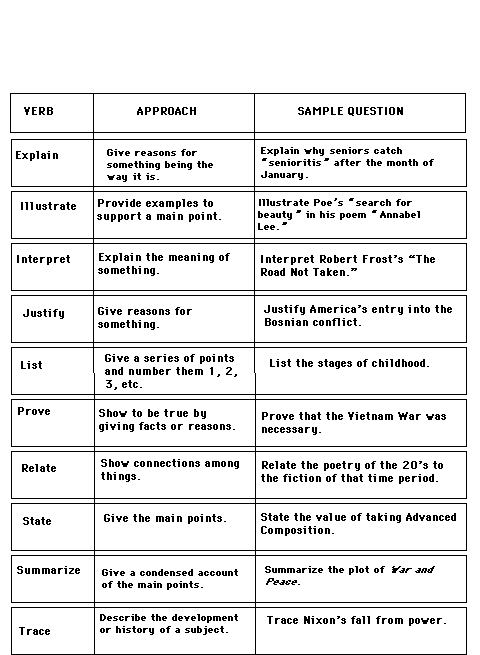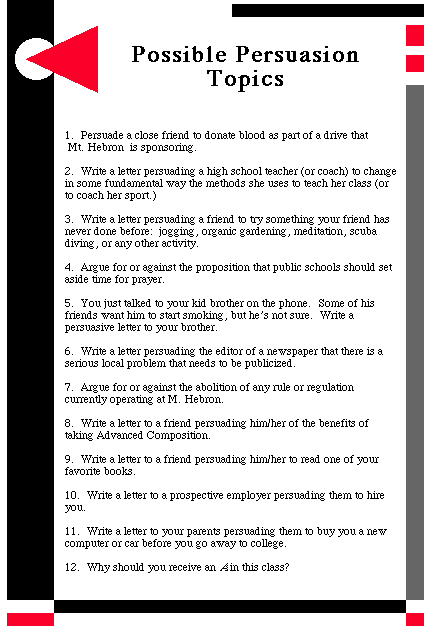Responding
to the Essay Question
If you wish, click on individual
topics or scroll through entire page.
1. Introduction/Taking
Essay Exams
2. Analyze
3. Illustrate
4. Persuade/Prove
5. Interpret

Taking
Essay Exams
Essay exams are very common on
the college level. First of all, it is assumed that you will attend class
regularly, take accurate notes, and complete all reading and writing assignments.
It is even a good idea to take notes on your assigned readings and notes
on your notes! However, there are some easy steps to help you prepare for
the inevitable essay exam:
Step 1: Before the test day,
predict probable questions.
Step 2: Prepare and memorize
an informal outline answer for each question.
Step 3: At the actual test, analyze
the exam question carefully to determine an approach for developing an
answer. Be certain that you are answering the stated question and not the
question you "wished" had been asked.
Step 4: Prepare a brief, informal
outline or graphic organizer before writing your answer.
Step 5: Write a clear, well-organized
essay which includes the following essentials:
- An interesting introductory
paragraph which contains your thesis statement and controls, if appropriate.
- A body which contains facts,
quotes, examples--proof of your thesis statement and proof that you have
actually done the readings.
- Use lively, clear words and
a variety of sentence types.
- Employ transitional sentences
between paragraphs and "connecting" words to guide your reader
through the essay.
- A conclusion which restates
your answer to the question (your thesis) in an insightful manner and perhaps
draws any further conclusions or predictions.
- Watch your time so that all
parts of the essay are completed in time for you to proofread your writing.
(When making corrections, you should make them neatly.)



Analyze
Analyze: to divide something into parts to
see how each part works.
Choose one of the following questions and respond
in essay form. Begin with a prewriting activity (outline, web, or jot list);
compose a first draft with appropriate introduction, body, and conclusion;
proofread for sense and mechanics. Complete a final draft. Be sure to include
an interesting title. Turn in all parts of the assignment.
1. Choose a person you admire. Analyze how
this person inspires you and why?
2. Analyze your senior year as a period of
growth and maturity.
3. Consider an area in which you have achieved
at least moderate success, for example academics, sports, the arts, social
relationships, or family relationships. Analyze how you have achieved success
in this area.
4. Think of a situation in which you failed
miserably. Analyze how this failure occurred. Did you learn anything from
this experience?

 Illustrate
Illustrate
Illustrate: Provide examples to support a main
point.
Sample questions:
1. Illustrate Robert Frost's use of end rhyme
in "A Snowy Evening."
2. Illustrate how Americans are infatuated
with violence.
3. Illustrate the responsibilities of a college
student.
Step One: Develop a thesis statement. Example--Americans
are infatuated with violence.
Step Two: Brainstorm examples that actually
support your thesis--
- relevant facts
- statistics
- personal experiences
- incidents
- quotes
- examples
Step Three: Organize each paragraph of the
body of your paper by grouping several examples that support a particular
point in separate paragraphs or use one extended example (an incident or
story) that may take up a full paragraph. Save the paragraph containing
the most vivid, convincing, or important examples for last.
Step Four: Conclude with a summary paragraph
which restates your thesis and ends with a persuasive or insightful statement.
Choose one of the following statements and
respond in the form of an illustration essay. Begin with a prewriting activity
(outline, web, or jot list); develop a thesis statement with controls;
compose a first draft with appropriate introduction, body, and conclusion;
proofread for sense and mechanics. Complete a final draft. Be sure to include
an interesting title.
1. Our lives would be improved without the
automobile.
2. Looking for a job can be a stressful process.
3. If you look hard enough, you can see complete
strangers being kind to one another.
4. High school seniors are excellent models
for the underclassmen.

Persuade/Prove
When you are asked to prove something
you are expected to show something to be true by giving facts or reasons.
It is your goal to persuade your reader of your point of view.
View Elements of
Persuasion PowerPoint
There are several organizational
strategies available to you when you write a persuasive essay:
Using Order of Importance
One of the most common and effective
methods of organization in a persuasive essay is order of importance. One
way to use this method is to rank and discuss your evidence from most important
to the least important. Then refute any arguments against your evidence
by showing how or why these arguments are illogical, impractical, or unsound.
Finally, end with a strong ending that your reader will remember.
| Thesis Statement |
Most Important Evidence |
Next Important Evidence |
Least Important Evidence |
Refuting Opposing Arguments |
Conclusion |
As an alternative to stating
your own position first, as in order of importance, you might begin your
persuasive essay by analyzing and refuting the arguments of the opposing
side. This organization pattern is especially effective with highly controversial
issues. By debunking the opposition first you make your audience more receptive
to your ideas. After you refute opposing arguments, clearly state your
own position and support it with evidence.
| Refuting Opposing Arguments |
Thesis Statement |
Most Important Evidence |
Next Important Evidence |
Least Important Evidence |
|

|


Interpret
The word interpret in
a question asks for you to give the meaning, message, theme, or significance
of something. (This is usually a step beyond the analysis of a work, which
implies that you will look at the various aspects of a work. For example,
in a poem you would analyze the rhyme, rhythm, figurative language, stanza
form, historical period, to mention only a few.)
Examples:
- Provide an interpretation for
the symbol of the road in Robert Frost's "The Road Not Taken."
- Interpret the meaning of Poe's
"The Raven."
- Interpret what is meant by
this statement: "The only thing we have to fear is fear itself."
Step One: Read your literary
work to find a "focus" around a dominant or universal theme.
(Theme: the central or dominating idea in a literary work. Examples: jealousy,
love, pride, courage, hate, values, growing up, freedom, loss, discovery,
imagination, humor, satire, generations.)
Step Two: State this universal
theme in the form of a thesis statement (for a longer paper) or topic sentence
(for a paragraph). (Thesis: An attitude or position on a problem taken
by a writer or speaker with the purpose of proving or supporting it.)
Step Three: Show the overall
development of the work in light of the thesis statement. Always use quotes
and examples which support or prove your thesis statement (your original
interpretation).
Step Four: End by asserting the
significance of the thesis and the work you have just discussed. (This
should be a natural outgrowth of your paper. It should not be something
that is just "tacked on" to the end of your paper.)
Return to top of page.
List of Works Consulted
Return to Advanced Composition.
Email: mrsbeachy@hotmail.com
|
![]()






